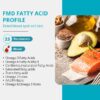- Your cart is empty
- Continue Shopping
‘All tests we do at FMD are aimed at finding the root cause of your health problem. These are not the usual diagnostic tests that you do, but much, much more.’
‘All tests we do at FMD are aimed at finding the root cause of your health problem. These are not the usual diagnostic tests that you do, but much, much more.’

₹5,500.00 ₹3,000.00
₹5,500.00 ₹3,000.00
Test Parameters:
Fatty acid imbalances can be a causative factor in a variety of chronic health conditions. The Fatty Acids Profile Test – Bloodspot assesses the critical balance between essential Omega-6 and Omega-3 fatty acids.
 Reporting Time: 7 Days After Sample Received
Reporting Time: 7 Days After Sample Received One Prick Sample
One Prick Sample Best and Honest Price
Best and Honest PriceFatty acid imbalances can be a causative factor in a variety of chronic health conditions. The Fatty Acids Profile – Bloodspot assesses the critical balance between essential Omega-6 and Omega-3 fatty acids. The Fatty Acids Profile Test can indicate the need for fatty acid supplementation and/or dietary modification.
The Omega 6 Omega 3 Test might be for you if you are facing:
The DHA Blood test measures 23 fatty acids, including omega 3, omega 6 saturated, monounsaturated, trans fatty acids, Omega 3 index, Omega 6:3 ratio & AA:EPA ratio.
Omega-3’s have many benefits because they are the primary building blocks in your cell. EPA is dominant in the blood, muscles and tissues, while DHA is dominant in the brain, sperm and eyes.
An optimum Omega- 6:3 is important for maintaining normal cell and tissue development (homeostasis) and helps the body control inflammation.
Order a Fatty Acid Test it is just a few simple step!
Please enter the data where the Fatty Acid set should be send
Detailed instructions and a return envelope you will find in the Fatty Acid set.
After 7 working days , you will receive detailed Fatty Acid analysis .
Our Working Process Healthcare model is shifting from Sickness care to Wellness.
Sample collection will be done from home

Sample is processed at Central Lab of our Trusted Partners.

Reports are accessible online.
Sample collection will be done from home

Sample is processed at Central Lab of our Trusted Partners.

Reports are accessible online.
Fatty Acid Profile Test FAQ's Functional Medicine Diagnostics FAQ's
During digestion, the body breaks down fat into long chain hydrocarbons called fatty acids which are then absorbed in the blood. These fatty acids then become fundamental building blocks of more structurally complex lipids, including esters, triglycerides, phospholipids, and glycolipids. They are separated into 4 categories: saturated, monounsaturated, polyunsaturated, and trans fats.
These are polyunsaturated fatty acids that are not produced in the body and are thus essential to obtain from our diet in a balanced proportion. In “omega 3” the position of the last double bond is on the third carbon atom from “omega” or tail end. They play a crucial role in building of cell membranes, besides which they are also important for heart, brain and metabolism.
“Omega 6” refers to those essential fatty acids where the final double bond is on the sixth carbon atom from “omega” or tail end. They are proinflammatory in nature and play a key role in the immune system. However, when the body produces it more than required, it increases the risk of inflammation and related diseases. Thus, it is required to maintain a balanced ratio between omega 3 and omega 6 fatty acids.
The three main omega-3 fatty acids are alpha-linolenic acid (ALA), eicosapentaenoic acid (EPA), and docosahexaenoic acid (DHA). ALA is found mainly in plant oils such as flaxseed, soybean, and canola oils. DHA and EPA are found in fish and other seafood.
Research has consistently shown that at least 2000 mg of EPA/DHA daily is necessary to reach a healthy omega 3 index level.
The optimal ratio of omega-6:omega-3 varies from 1:1 to 4:1 depending on the disease under consideration. Human cells cannot convert omega-6 to omega-3 fatty acids because they lack the converting enzyme, omega-3 desaturase. These two classes of EFA are not interconvertible, are metabolically and functionally distinct, and often have important opposing physiological functions. Thus, the balance of omega-6 and omega-3 fatty acids is very important for homeostasis and normal development.
A diet rich in omega-6 fatty acids shifts the physiological state to one that is prothrombotic and proinflammatory, with increases in blood viscosity, vasospasm, and vasoconstriction and decreases in bleeding time. Many experimental studies have provided evidence that incorporation of alternative fatty acids into tissues may modify inflammatory and immune reactions and that omega-3 fatty acids in particular are potent therapeutic agents for inflammatory diseases.
Cellular proteins are genetically determined, However, the fat composition of cell membranes is to a great extent dependent on the dietary intake. Many of the chronic conditions, cardiovascular disease, diabetes, cancer, obesity, autoimmune diseases, rheumatoid arthritis, asthma and depression, are associated with increase in omega-6 fatty acid intake and decrease by increases in omega-3 fatty acid intake. Hence, testing is required to understand the composition of fat in your dietary intake.
Avoid alcohol 24 to 48 hours before the test and keep fasting for 9 to 12 hours before sample collection.
The fatty acid profile test is an at home dried blood spot test. The test measures 23 fatty acids, including omega 3, omega 6 saturated, monounsaturated, trans fatty acids, Omega 3 index, Omega 6:3 ratio & AA:EPA ratio.
Step 1: Purchase the test via the website
Step 2: Kit is dispatched to you along with the instructions
Step 3: Sample collection done by you
Step 4: Kit is shipped to the lab for sample analysis
Step 5: Sample Analysed at the lab
Step 6: Reports accessible online
The ratio of omega-6 to omega-3 EFA is an important determinant of health. Therefore, appropriate amounts of dietary omega-6 and mega-3 fatty acids at a ratio of about 1-2/1 consistent with the recommended adequate intakes (AI) should be considered in the diet. The adverse effects of too much omega 6 PUFAs can be avoided by two interdependent dietary changes. First, the amount of plant oils rich in Linoleic Acid, the parent compound of the omega-6 class, needs to be reduced. Second, simultaneously the omega-3 PUFAs need to be increased in the diet.
Fatty acid profile is effective for patients experiencing
Other Popular Test Packages Choose from our frequently booked test packages.